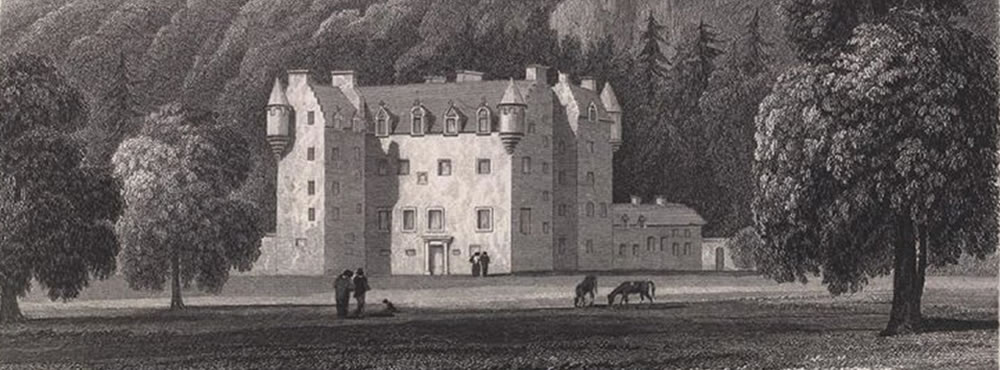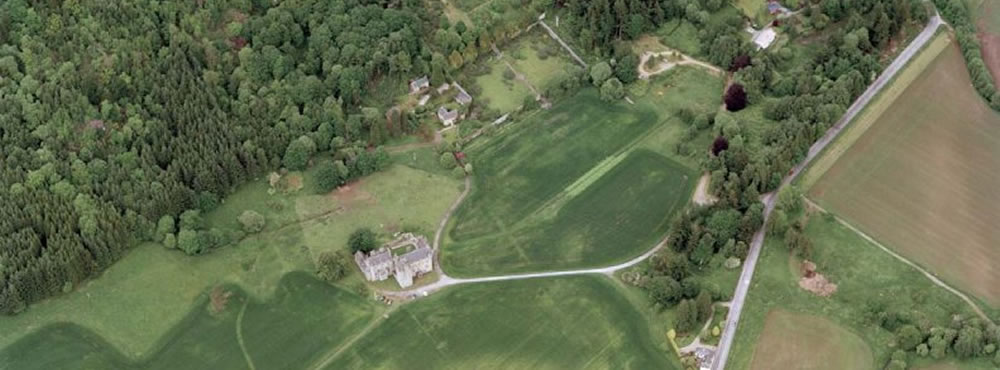History of Castle Menzies
It is believed that Menzies families were well established in Perthshire by the middle of the 12th century. They had earlier strongholds before the present castle, such as Comrie Castle which is situated between the River Lyon and the high ground leading up to Drummond Hill to its south and 4 miles west of Castle Menzies, and which is just a small ruin now.
Garth Castle is another which has early Menzies ownership. It was restored in the middle of the nineteenth century as a private residence. Likewise, nearby Grandtully Castle, currently also a private residence, was, in an older version, once Menzies owned. Others, left to the elements and less well-known, are on the Isle of Loch Tay (eastern end) and Castle Mains near Ardeonaig farther west on Loch Tay's south shore.
The Place at Weem
After a fire at Comrie Castle, our present area under Weem Rock was chosen by Sir Robert Menzies (11th Baron of Menzies) in 1488 to build a new mansion. Considerably smaller than the present Castle Menzies, this new stronghold was called the Place of Weem.
Z-plan Castle
Unfortunately the Place at Weem too was burnt down when attacked by Neil Stewart, the then owner of Garth Castle, in 1502. At some point thereafter, it was rebuilt and enlarged into the sixteenth century Z-shaped building which is Castle Menzies' most distinguishing feature. It is not entirely certain that this second building is on exactly the same site as the older one, but there is a fair amount of evidence to suggest that what was the Place at Weem now forms the Eastern end of the main body of the Z-plan part of the Castle. The most striking piece of evidence for this is the incredibly thick internal wall between the Pink Room (hall) and its ante-chamber on the first floor, which only makes sense if it was once an external wall of an earlier stronghold.
The z-plan Castle was designed not only as a residence but also was required to provide some protection from enemies. It is thought that the earliest version of the Z-plan Castle had battlements and was topped by two towers well above the height of the current roofline, perhaps one as a belltower and one as a lookout.
By 1577 this latter problem was thought to have diminished and alterations were made, particularly to the roof area, making it less of a fortress and giving it its present appearance. It is thought that at this time the current shape and extent of the roof, and its ornate dormer windows, were set out as they are seen today.
Turbulent times
Later the Castle had to survive through the Covenanter religious troubles of the mid-seventeenth century and the Jacobite rebellions of 1715 and 1745.
In 1715 it was occupied by the Jacobites. Again in the 'Forty-five rebellion it was occupied by the Jacobites, including their leader Prince Charles Edward Stuart (Bonnie Prince Charlie), who rested on his way to Culloden in 1746, only four days later for the Castle to be garrisoned by the Duke of Cumberland, son of the British Monarch and commander of the Government forces.
Later additions
A new wing was added to the rear of the Castle in early eighteenth century which introduced new entertaining rooms, bedrooms, bathrooms and a grand wooden staircase. The present main entrance was then formed at the front of the Castle, taking over from the smaller entrance with the old yett in the South-West tower, although the current porch was added later in Victorian times. The older building was much altered and decorated to incorporate the access to the new wing on all floors via the new staircase.
An extensive complex of kitchens, storerooms, stables, game rooms, servants' quarters and other outbuildings were added to the rear of the Castle, stretching for a considerable distance. All that remains of these is now the Warden's Cottage and a few low walls.
In 1840 a major change to the Castle came with the addition of an entirely new wing, designed by architect William Burn using the same stone (quarried from the hillside on south side of Loch Tay) and the style in keeping with the old building. It connected up with the 18th century added wing.
Decline and sale
In 1665 Sir Alexander Menzies of Menzies had been created a Baronet of Nova Scotia and this title continued until the 8th Baronet, Sir Neil Menzies, who died without heirs in 1910. In 1914 the extensive Menzies estates were divided and auctioned by his trustees. With the divided estates were also sold the Castle and its contents, including many Clan Menzies relics. To recreate a tragedy little less than the earlier destruction of the ancient Clan documents by the burning of the Place of Weem in 1502, the contents of the muniment room were apparently bundled into lots and sold, scattering four hundred years of documented history of the family and district.
Even before its sale in 1914 the Castle had begun its sad decline, as it had been rented out and not lived in by the Menzies family, who had moved to Farleyer, a smaller mansion, a mile or so to the West. After its first passing from the Menzies family the Castle had various owners and tenants, none of who were able to maintain it properly, until in 1957 it was bought as a ruin by the decision taken at the first meeting of what is now the Menzies Clan Society. This was a re-forming from an older Clan Society first started in 1892 but which had to stop activities during both World Wars.
Saved by the Menzies Clan Society
In 1957 the Castle was purchased as a semi-ruin, for under £300, by the Menzies Clan Society - very much in faith and hope, as there was very little money or means to do anything with it. However, it was thought important for the newly resuscitated Clan Society to have this very appropriate historical base.
Thus the members of the Clan Society have replaced the Menzies family and it is thought this is a unique situation for a clan castle and a very enviable one. Other clans have lost their castles to complete ruins or the old residences have been sold out of their clans to others and a few are still owned by their own Chiefs. Some have built modern centres for themselves as headquarters.
Some roof repairs and some demolition of eastern outhouses took place during the first 14 years of ownership by the Clan Society. It was visited by members when on holiday and on the annual Clan Gathering day afternoon (not a weekend event then). This was due to the kindness of Mr William Hood (Willie) and his wife Mrs Mary Hood or Menzies in keeping the key and an eye on it from their home in the South Lodge and often in guiding people round the castle. It was not open to the general public as it was in far too dangerous a condition for that.
It was not until 1971-2 that surveys were carried out which indicated that some much more active work would be required or the Castle would be lost. Plans were drawn up for the restoration of the oldest part, the sixteenth century Z-plan part, and appeals were put out for funds. A grant was obtained from Historic Buildings Council for Scotland (now Historic Scotland) and work commenced in September 1972. This was an extremely significant piece of restoration and, not surprisingly, took many years. It was led by Dr A D Dewar (Bill) and his wife Ann, who spent a great deal of time and effort into researching what was needed, raising funds and often hard, physical graft in a very hands-on style.
As things progressed it was, in an unofficial way, made open to the public. Mostly they had to be guided round as there were still dangerous areas. But this was the way forward - this way it might pay for its normal running costs. Although some contributions of money and physical help came from the Clan Society members and some local people, it was insufficient and much more of the work had to be grant-aided and it needed staff. The unoffical viewings continued until there was a house available for a permanent warden. This was completed out of the old western outbuildings in 1983 and the first Castle Warden was appointed. Nowadays this role has developed into our Castle Manager.
The restoration of the Victorian (or West) wing began in 1990, this part of the building having been isolated up until then, to prevent spreading of rot. Again we were advised that action would need to take place as one part was in danger of collapse. A connecting passage between the sixteenth century Z-plan building and the Victorian wing had to be built so that access was restored, although only at ground level. This work allowed a tearoom to be opened on the ground floor and the first floor room, known as the ballroom, was fully restored. It has now been renamed the Dewar Room to mark the work done by Dr & Mrs Dewar. The first Menzies Clan Society dinner was held in this room in 1995 and it is largest and grandest of the rooms in the Castle. The Dewar Room is being increasingly hired out for weddings and other special celebrations and concerts.
The second floor of the Victorian wing now houses the Menzies Clan Society's library, the Society's archive and a fine room which we currently call the Chief's Sitting Room which is used for Society and Trustees' meetings. There is still scope for further restoration of this floor and the second floor above.
Charitable status
The Menzies Clan Society set up a separate charity, the Menzies Charitable Trust, in 1993 to own and run the Castle, along with the Castle's original walled garden, which had been purchased in 1984, and the Menzies Mausolem set within the Old Kirk of Weem, the old church in Weem village which had been traditionally in the ownership of Menzies Chiefs, and where many of them who lived in the Castle are buried. That charity became The Castle Menzies SCIO in 2023, and it maintains strong links with the Menzies Clan Society, including sharing senior post-holders.
The above history can only give a flavour of what Menzies connections can be discovered in a very large area around the Castle but, even if delving into these historical connections is not to your liking, it is a very beautiful part of the country and worth exploring on scenic grounds alone. A booklet on sale at the Castle gives more details of its history.


